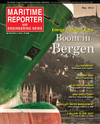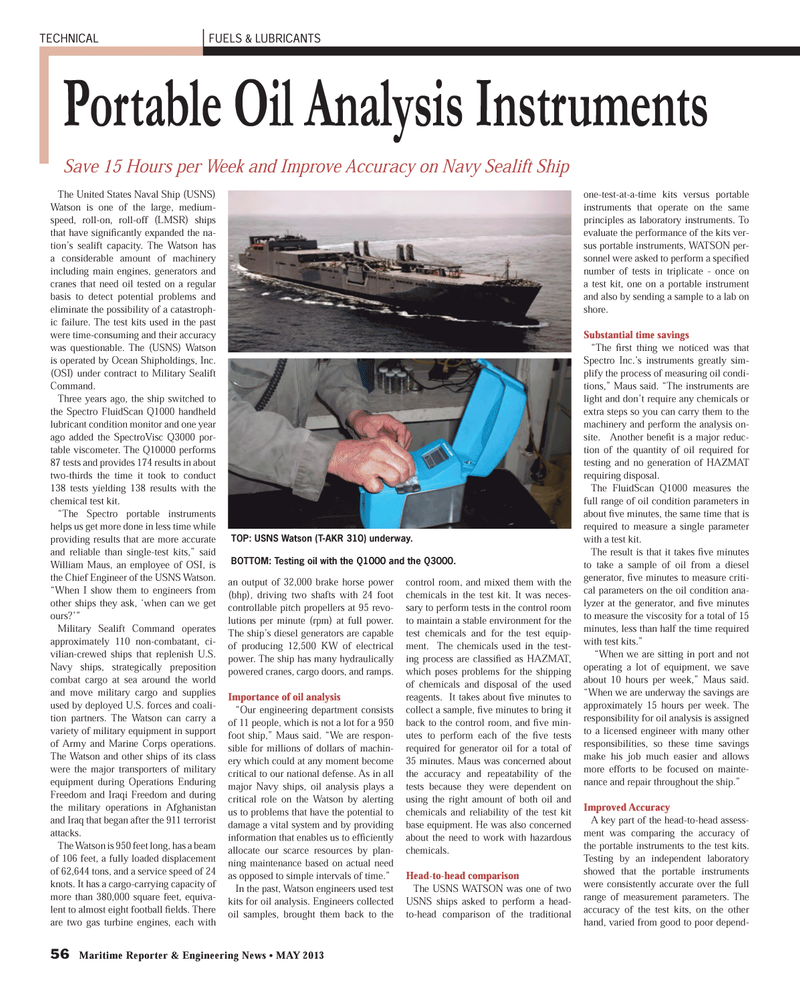
Page 56: of Maritime Reporter Magazine (May 2013)
Energy Production & Transportation
Read this page in Pdf, Flash or Html5 edition of May 2013 Maritime Reporter Magazine
56 Maritime Reporter & Engineering News ? MAY 2013 The United States Naval Ship (USNS) Watson is one of the large, medium- speed, roll-on, roll-off (LMSR) ships that have signiÞ cantly expanded the na- tion?s sealift capacity. The Watson has a considerable amount of machinery including main engines, generators and cranes that need oil tested on a regular basis to detect potential problems and eliminate the possibility of a catastroph-ic failure. The test kits used in the past were time-consuming and their accuracy was questionable. The (USNS) Watson is operated by Ocean Shipholdings, Inc. (OSI) under contract to Military Sealift Command.Three years ago, the ship switched to the Spectro FluidScan Q1000 handheld lubricant condition monitor and one year ago added the SpectroVisc Q3000 por- table viscometer. The Q10000 performs 87 tests and provides 174 results in about two-thirds the time it took to conduct 138 tests yielding 138 results with the chemical test kit. ?The Spectro portable instruments helps us get more done in less time while providing results that are more accurate and reliable than single-test kits,? said William Maus, an employee of OSI, is the Chief Engineer of the USNS Watson. ?When I show them to engineers from other ships they ask, ?when can we get ours??? Military Sealift Command operates approximately 110 non-combatant, ci- vilian-crewed ships that replenish U.S. Navy ships, strategically preposition combat cargo at sea around the world and move military cargo and supplies used by deployed U.S. forces and coali-tion partners. The Watson can carry a variety of military equipment in support of Army and Marine Corps operations. The Watson and other ships of its class were the major transporters of military equipment during Operations Enduring Freedom and Iraqi Freedom and during the military operations in Afghanistan and Iraq that began after the 911 terrorist attacks. The Watson is 950 feet long, has a beam of 106 feet, a fully loaded displacement of 62,644 tons, and a service speed of 24 knots. It has a cargo-carrying capacity of more than 380,000 square feet, equiva-lent to almost eight football Þ elds. There are two gas turbine engines, each with an output of 32,000 brake horse power (bhp), driving two shafts with 24 foot controllable pitch propellers at 95 revo-lutions per minute (rpm) at full power. The ship?s diesel generators are capable of producing 12,500 KW of electrical power. The ship has many hydraulically powered cranes, cargo doors, and ramps. Importance of oil analysis?Our engineering department consists of 11 people, which is not a lot for a 950 foot ship,? Maus said. ?We are respon- sible for millions of dollars of machin-ery which could at any moment become critical to our national defense. As in all major Navy ships, oil analysis plays a critical role on the Watson by alerting us to problems that have the potential to damage a vital system and by providing information that enables us to efÞ ciently allocate our scarce resources by plan-ning maintenance based on actual need as opposed to simple intervals of time.?In the past, Watson engineers used test kits for oil analysis. Engineers collected oil samples, brought them back to the control room, and mixed them with the chemicals in the test kit. It was neces-sary to perform tests in the control room to maintain a stable environment for the test chemicals and for the test equip-ment. The chemicals used in the test- ing process are classiÞ ed as HAZMAT, which poses problems for the shipping of chemicals and disposal of the used reagents. It takes about Þ ve minutes to collect a sample, Þ ve minutes to bring it back to the control room, and Þ ve min- utes to perform each of the Þ ve tests required for generator oil for a total of 35 minutes. Maus was concerned about the accuracy and repeatability of the tests because they were dependent on using the right amount of both oil and chemicals and reliability of the test kit base equipment. He was also concerned about the need to work with hazardous chemicals.Head-to-head comparisonThe USNS WATSON was one of two USNS ships asked to perform a head-to-head comparison of the traditional one-test-at-a-time kits versus portable instruments that operate on the same principles as laboratory instruments. To evaluate the performance of the kits ver- sus portable instruments, WATSON per- sonnel were asked to perform a speciÞ ed number of tests in triplicate - once on a test kit, one on a portable instrument and also by sending a sample to a lab on shore.Substantial time savings?The Þ rst thing we noticed was that Spectro Inc.?s instruments greatly sim- plify the process of measuring oil condi-tions,? Maus said. ?The instruments are light and don?t require any chemicals or extra steps so you can carry them to the machinery and perform the analysis on-site. Another bene Þ t is a major reduc- tion of the quantity of oil required for testing and no generation of HAZMAT requiring disposal. The FluidScan Q1000 measures the full range of oil condition parameters in about Þ ve minutes, the same time that is required to measure a single parameter with a test kit. The result is that it takes Þ ve minutes to take a sample of oil from a diesel generator, Þ ve minutes to measure criti- cal parameters on the oil condition ana-lyzer at the generator, and Þ ve minutes to measure the viscosity for a total of 15 minutes, less than half the time required with test kits.? ?When we are sitting in port and not operating a lot of equipment, we save about 10 hours per week,? Maus said. ?When we are underway the savings are approximately 15 hours per week. The responsibility for oil analysis is assigned to a licensed engineer with many other responsibilities, so these time savings make his job much easier and allows more efforts to be focused on mainte- nance and repair throughout the ship.?Improved Accuracy A key part of the head-to-head assess- ment was comparing the accuracy of the portable instruments to the test kits. Testing by an independent laboratory showed that the portable instruments were consistently accurate over the full range of measurement parameters. The accuracy of the test kits, on the other hand, varied from good to poor depend-TECHNICALFUELS & LUBRICANTSPortable Oil Analysis Instruments Save 15 Hours per Week and Improve Accuracy on Navy Sealift Ship TOP: USNS Watson (T-AKR 310) underway. BOTTOM: Testing oil with the Q1000 and the Q3000. MR #5 (50-57).indd 56MR #5 (50-57).indd 565/2/2013 10:13:22 AM5/2/2013 10:13:22 AM

 55
55

 57
57
